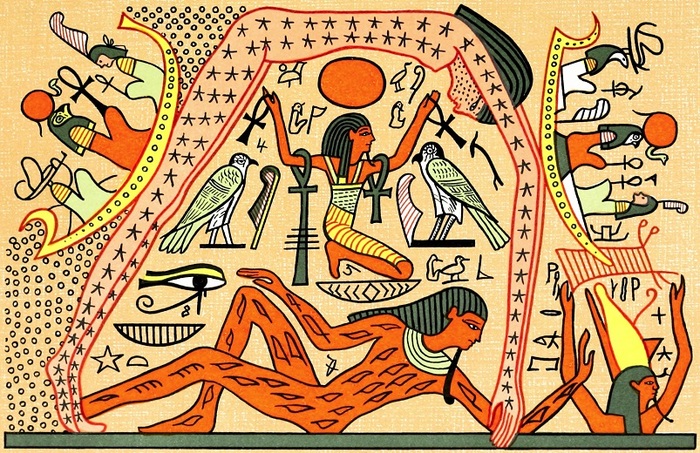By Tom Metcalfe -
NBC News
Lauri Jetsu, an astrophysicist at the University of Helsinki, follows a tradition that can be traced back thousands of years and has to do with the reasons why the star Algol, known as the "demon star", visibly changes in brightness every few days. .
His research of more than a decade suggests that such fluctuations have been seen at least since ancient Egyptian times and he believes that observations made more than 3,000 years ago may contribute to the modern scientific understanding of why Algol behaves that way. .
Jetsu's latest study, published last month in the Astrophysical Journal, suggests that it
could be orbited by up to five more stars
, most of them too faint to be seen.
“It was a surprise to me,” he said, “the probability of finding two more stars is already very low.
Nobody has found so many ”.
An impression of the Algol system.Getty Images / Science Photo Libra
Algol takes its name from the Arabic phrase "Raʾs al-Ghūl", which means "the head of the demon",
also the name of a Batman villain
.
It has long been considered a "bad luck star", possibly because of its changes in brightness.
Astronomers have known since the 1880s that Algol is an
eclipsing binary star
.
Their brightness changes are due to the fact that two stars orbit a few million kilometers apart, so that here on Earth they look like a single star.
The bright light from the larger star is
blotted out
every few days by its dimmer and much smaller companion.
But scientists debate whether the small variations in Algol's light
could be caused by more stars in the system
.
To answer this, Jetsu applied a new mathematical method to years of data recorded from Algol's light and revealed regular signals suggesting that there may be up to five companion stars in the system.
This is how NASA prepares to take a woman to the Moon for the first time on the Artemis 1 mission
Nov. 8, 202103: 29
One of the companions is known to be the third star in Algol, orbiting the central pair at a distance of about twice that between the Earth and the Sun.
Many other stars have an orbiting companion star, called double or binary stars, and a few have evolved to have three.
But
the new study reinforces the idea that Algol has up to four
more companion
stars
that have yet to be seen.
Jetsu said the companions will have to be verified through observations, perhaps with an astronomical technique called interferometry, to distinguish their light from the glare of the two main stars.
Jetsu and his colleagues have published four research articles on Algol.
He wears a hieroglyphic tattoo on his right hand with the ancient Egyptian name of the star.
"I put it in 2018 because it
took us about 10 years to publish our results
, and two of my co-authors died during that time," he said.
[The third manned commercial mission of NASA and SpaceX takes off in Florida]
Jetsu suggests that ancient Egyptians had observed Algol's brightness changes,
which can be seen with the naked eye
.
It becomes noticeably dimmer for about 10 hours almost every three days, when the smaller star of the central pair, which orbits closely, eclipses or passes in front of the larger star.
Jetsu's research also suggests that changes in the duration of Algol's eclipses recorded in ancient times and today (they
are
now
almost half an hour shorter than 3,200 years ago
), can be used to determine how fast the star Algol's smallest core is being eaten away by the gravity of its largest star, as astrophysical theories predict.
It is not known for sure, but the idea that
Algol was an unlucky star
may have been adopted from Egypt by the ancient Greeks, who decided that it represented an eye on the head of the gorgon Medusa.
According to the myth, Medusa was killed by the hero Perseus, whose constellation dominates that part of the sky.
Ancient star charts show Perseus grasping the head of Medusa, who had retained the power to turn the living to stone.
NASA releases spectacular images of the planet Jupiter taken by a space probe
Nov. 1, 202100: 49
Algol's common name
comes from medieval Arabic tradition
and appears to be based on that Greek tradition, said astronomer Ed Krupp, director of the Griffith Observatory in Los Angeles.
"This does not reflect an ancient popular tradition of a strange and eerily variable star," he said, "in fact, it is a consequence of the transmission of Greek astronomy to the Islamic world."
Krupp has written several books on ancient astronomy, but has not participated in the latest research.
Algol's visible changes in brightness have led modern astronomers to wonder if its unusual behavior was noticed in ancient times, but that has not been scientifically established, he said.
Even so,
the demon star's evil reputation persists.
"Part of the appeal of any Algol story is the romance associated with the star," he said.
[The four crew members of SpaceX Crew-2 return to Earth after six months in space]
Astrophysicist Jason Ybarra, a visiting professor at Davidson College in North Carolina, who was not involved in the study, is cautious about the results.
"The probability of a multiple star system consisting of seven stellar companions forming is very low," he said.
He added that more research could be done to rule out other causes of the regular light variations detected in Algol, such
as cycles in the main stars' magnetic fields
that could directly affect their brightness.
[Russia exploded the most powerful atomic bomb in history. The US response averted an even greater danger]
But "Algol is a very important system to study, because it is the first eclipsing binary ever discovered and therefore we have the longest time baseline of observation," he said.
"Jetsu's work
is important for understanding eclipsing binaries
and possibly exoplanetary systems," he added.














